+ Open data
Open data
- Basic information
Basic information
| Entry | Database: PDB / ID: 4csu | |||||||||
|---|---|---|---|---|---|---|---|---|---|---|
| Title | Cryo-EM structures of the 50S ribosome subunit bound with ObgE | |||||||||
 Components Components |
| |||||||||
 Keywords Keywords | RIBOSOME / (P)PPGPP / OBG / RIBOSOME ASSEMBLY / STRINGENT RESPONSE / GTPASE | |||||||||
| Function / homology |  Function and homology information Function and homology informationguanyl ribonucleotide binding / dormancy process / negative regulation of ribosome biogenesis / guanosine tetraphosphate binding / stringent response / ribosomal large subunit binding / transcriptional attenuation / endoribonuclease inhibitor activity / positive regulation of ribosome biogenesis / RNA-binding transcription regulator activity ...guanyl ribonucleotide binding / dormancy process / negative regulation of ribosome biogenesis / guanosine tetraphosphate binding / stringent response / ribosomal large subunit binding / transcriptional attenuation / endoribonuclease inhibitor activity / positive regulation of ribosome biogenesis / RNA-binding transcription regulator activity / translational termination / negative regulation of cytoplasmic translation / DnaA-L2 complex / translation repressor activity / negative regulation of translational initiation / negative regulation of DNA-templated DNA replication initiation / mRNA regulatory element binding translation repressor activity / assembly of large subunit precursor of preribosome / cytosolic ribosome assembly / response to reactive oxygen species / ribosome assembly / chromosome segregation / regulation of cell growth / DNA-templated transcription termination / response to radiation / mRNA 5'-UTR binding / GDP binding / large ribosomal subunit / transferase activity / ribosome binding / 5S rRNA binding / ribosomal large subunit assembly / large ribosomal subunit rRNA binding / cytosolic large ribosomal subunit / Hydrolases; Acting on acid anhydrides; Acting on GTP to facilitate cellular and subcellular movement / cytoplasmic translation / tRNA binding / negative regulation of translation / rRNA binding / structural constituent of ribosome / ribosome / translation / response to antibiotic / negative regulation of DNA-templated transcription / GTPase activity / mRNA binding / GTP binding / magnesium ion binding / DNA binding / RNA binding / zinc ion binding / cytosol / cytoplasm Similarity search - Function | |||||||||
| Biological species |  | |||||||||
| Method | ELECTRON MICROSCOPY / single particle reconstruction / cryo EM / Resolution: 5.5 Å | |||||||||
 Authors Authors | Feng, B. / Mandava, C.S. / Guo, Q. / Wang, J. / Cao, W. / Li, N. / Zhang, Y. / Zhang, Y. / Wang, Z. / Wu, J. ...Feng, B. / Mandava, C.S. / Guo, Q. / Wang, J. / Cao, W. / Li, N. / Zhang, Y. / Zhang, Y. / Wang, Z. / Wu, J. / Sanyal, S. / Lei, J. / Gao, N. | |||||||||
 Citation Citation |  Journal: PLoS Biol / Year: 2014 Journal: PLoS Biol / Year: 2014Title: Structural and functional insights into the mode of action of a universally conserved Obg GTPase. Authors: Boya Feng / Chandra Sekhar Mandava / Qiang Guo / Jie Wang / Wei Cao / Ningning Li / Yixiao Zhang / Yanqing Zhang / Zhixin Wang / Jiawei Wu / Suparna Sanyal / Jianlin Lei / Ning Gao /   Abstract: Obg proteins are a family of P-loop GTPases, conserved from bacteria to human. The Obg protein in Escherichia coli (ObgE) has been implicated in many diverse cellular functions, with proposed ...Obg proteins are a family of P-loop GTPases, conserved from bacteria to human. The Obg protein in Escherichia coli (ObgE) has been implicated in many diverse cellular functions, with proposed molecular roles in two global processes, ribosome assembly and stringent response. Here, using pre-steady state fast kinetics we demonstrate that ObgE is an anti-association factor, which prevents ribosomal subunit association and downstream steps in translation by binding to the 50S subunit. ObgE is a ribosome dependent GTPase; however, upon binding to guanosine tetraphosphate (ppGpp), the global regulator of stringent response, ObgE exhibits an enhanced interaction with the 50S subunit, resulting in increased equilibrium dissociation of the 70S ribosome into subunits. Furthermore, our cryo-electron microscopy (cryo-EM) structure of the 50S·ObgE·GMPPNP complex indicates that the evolutionarily conserved N-terminal domain (NTD) of ObgE is a tRNA structural mimic, with specific interactions with peptidyl-transferase center, displaying a marked resemblance to Class I release factors. These structural data might define ObgE as a specialized translation factor related to stress responses, and provide a framework towards future elucidation of functional interplay between ObgE and ribosome-associated (p)ppGpp regulators. Together with published data, our results suggest that ObgE might act as a checkpoint in final stages of the 50S subunit assembly under normal growth conditions. And more importantly, ObgE, as a (p)ppGpp effector, might also have a regulatory role in the production of the 50S subunit and its participation in translation under certain stressed conditions. Thus, our findings might have uncovered an under-recognized mechanism of translation control by environmental cues. | |||||||||
| History |
| |||||||||
| Remark 700 | SHEET DETERMINATION METHOD: DSSP THE SHEETS PRESENTED AS "KA" IN EACH CHAIN ON SHEET RECORDS BELOW ... SHEET DETERMINATION METHOD: DSSP THE SHEETS PRESENTED AS "KA" IN EACH CHAIN ON SHEET RECORDS BELOW IS ACTUALLY AN 5-STRANDED BARREL THIS IS REPRESENTED BY A 6-STRANDED SHEET IN WHICH THE FIRST AND LAST STRANDS ARE IDENTICAL. THE SHEETS PRESENTED AS "WA" IN EACH CHAIN ON SHEET RECORDS BELOW IS ACTUALLY AN 6-STRANDED BARREL THIS IS REPRESENTED BY A 7-STRANDED SHEET IN WHICH THE FIRST AND LAST STRANDS ARE IDENTICAL. |
- Structure visualization
Structure visualization
| Movie |
 Movie viewer Movie viewer |
|---|---|
| Structure viewer | Molecule:  Molmil Molmil Jmol/JSmol Jmol/JSmol |
- Downloads & links
Downloads & links
- Download
Download
| PDBx/mmCIF format |  4csu.cif.gz 4csu.cif.gz | 2.4 MB | Display |  PDBx/mmCIF format PDBx/mmCIF format |
|---|---|---|---|---|
| PDB format |  pdb4csu.ent.gz pdb4csu.ent.gz | 1.5 MB | Display |  PDB format PDB format |
| PDBx/mmJSON format |  4csu.json.gz 4csu.json.gz | Tree view |  PDBx/mmJSON format PDBx/mmJSON format | |
| Others |  Other downloads Other downloads |
-Validation report
| Arichive directory |  https://data.pdbj.org/pub/pdb/validation_reports/cs/4csu https://data.pdbj.org/pub/pdb/validation_reports/cs/4csu ftp://data.pdbj.org/pub/pdb/validation_reports/cs/4csu ftp://data.pdbj.org/pub/pdb/validation_reports/cs/4csu | HTTPS FTP |
|---|
-Related structure data
| Related structure data |  2605MC M: map data used to model this data C: citing same article ( |
|---|---|
| Similar structure data |
- Links
Links
- Assembly
Assembly
| Deposited unit | 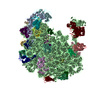
|
|---|---|
| 1 |
|
- Components
Components
+50S RIBOSOMAL PROTEIN ... , 30 types, 30 molecules 012345678CDEFGHIJKLMNOPQRSTUWY
-Protein , 1 types, 1 molecules 9
| #10: Protein | Mass: 43340.801 Da / Num. of mol.: 1 Source method: isolated from a genetically manipulated source Source: (gene. exp.)   |
|---|
-RNA chain , 2 types, 2 molecules AB
| #11: RNA chain | Mass: 38177.762 Da / Num. of mol.: 1 / Source method: isolated from a natural source / Source: (natural)  |
|---|---|
| #12: RNA chain | Mass: 941306.188 Da / Num. of mol.: 1 / Source method: isolated from a natural source / Source: (natural)  |
-Experimental details
-Experiment
| Experiment | Method: ELECTRON MICROSCOPY |
|---|---|
| EM experiment | Aggregation state: PARTICLE / 3D reconstruction method: single particle reconstruction |
- Sample preparation
Sample preparation
| Component | Name: 50S RIBOSOME BOUND WITH OBGE / Type: RIBOSOME |
|---|---|
| Buffer solution | Name: 20MM TRIS-HCL, 100MM NH4CL,10MM MGCL2 / pH: 7.5 / Details: 20MM TRIS-HCL, 100MM NH4CL,10MM MGCL2 |
| Specimen | Embedding applied: NO / Shadowing applied: NO / Staining applied: NO / Vitrification applied: YES |
| Specimen support | Details: CARBON |
| Vitrification | Instrument: FEI VITROBOT MARK IV / Cryogen name: ETHANE / Details: LIQUID ETHANE |
- Electron microscopy imaging
Electron microscopy imaging
| Experimental equipment |  Model: Titan Krios / Image courtesy: FEI Company |
|---|---|
| Microscopy | Model: FEI TITAN KRIOS / Date: Jul 27, 2011 |
| Electron gun | Electron source:  FIELD EMISSION GUN / Accelerating voltage: 300 kV / Illumination mode: FLOOD BEAM FIELD EMISSION GUN / Accelerating voltage: 300 kV / Illumination mode: FLOOD BEAM |
| Electron lens | Mode: BRIGHT FIELD / Nominal magnification: 59000 X / Nominal defocus max: 4000 nm / Nominal defocus min: 1000 nm / Cs: 2.7 mm |
| Image recording | Electron dose: 20 e/Å2 / Film or detector model: FEI EAGLE (4k x 4k) |
| Image scans | Num. digital images: 2000 |
- Processing
Processing
| EM software |
| ||||||||||||
|---|---|---|---|---|---|---|---|---|---|---|---|---|---|
| CTF correction | Details: INDIVIDUAL PARTICLES | ||||||||||||
| Symmetry | Point symmetry: C1 (asymmetric) | ||||||||||||
| 3D reconstruction | Method: REFERENCE PROJECTIONS / Resolution: 5.5 Å / Num. of particles: 102814 / Nominal pixel size: 1.5 Å / Actual pixel size: 1.5 Å Details: SUBMISSION BASED ON EXPERIMENTAL DATA FROM EMDB EMD-2605. (DEPOSITION ID: 12315) Symmetry type: POINT | ||||||||||||
| Atomic model building | Protocol: OTHER / Space: REAL / Details: REFINEMENT PROTOCOL--X-RAY | ||||||||||||
| Atomic model building | PDB-ID: 3OFC 3ofc Accession code: 3OFC / Source name: PDB / Type: experimental model | ||||||||||||
| Refinement | Highest resolution: 5.5 Å | ||||||||||||
| Refinement step | Cycle: LAST / Highest resolution: 5.5 Å
|
 Movie
Movie Controller
Controller




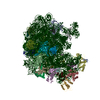

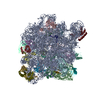
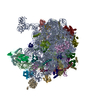

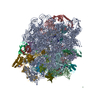


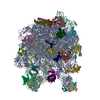
 PDBj
PDBj





























